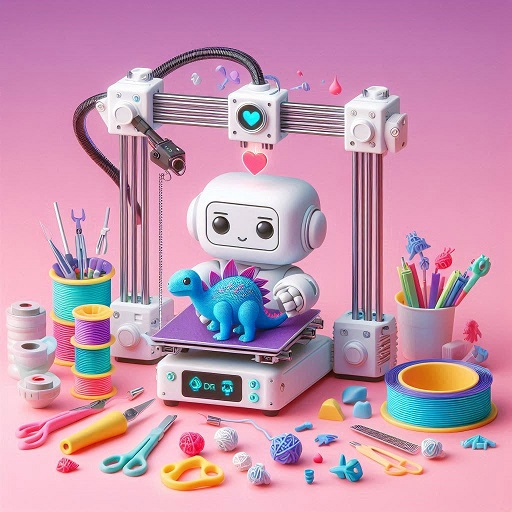Market Overview
The 3D printing robot market was valued at USD 1.6 billion in 2023 and is projected to reach USD 3.2 billion by 2028. This represents a compound annual growth rate (CAGR) of 14.6% during the forecast period from 2023 to 2029.
Driving Factors for Growth
The expansion of the 3D printing robot market is primarily fueled by several key factors:
- Government Investments: Increasing government funding for additive manufacturing initiatives is significantly contributing to market growth. These investments are aimed at enhancing technological advancements and innovation in 3D printing solutions.
- Automation Trends: There is a rising trend towards automated solutions that handle repetitive tasks, which enhances operational efficiency and improves workplace safety. The adoption of 3D printing robots allows organizations to streamline their processes and reduce the risk of workplace injuries.
- Industry Adoption: The automotive and electronics sectors are increasingly adopting 3D printing robots. This trend is driven by the need for rapid prototyping, customized parts, and the ability to produce complex geometries that traditional manufacturing methods cannot achieve.
Overall, these factors are propelling the growth of the 3D printing robot market, indicating a robust future for this innovative technology.
3D printing robots are transforming industries by enabling innovative applications across manufacturing, healthcare, construction, and art. Here’s a breakdown of the key applications:
Manufacturing Prototyping and Tooling
- Rapid Prototyping: 3D printing robots streamline the creation of prototypes, enabling designers to rapidly test and refine products. This significantly reduces the time from concept to market.
- Custom Tooling: These robots create custom tools, jigs, and fixtures used on factory floors, enhancing flexibility in production lines and lowering operational costs.
Healthcare and Prosthetics
- Customized Prosthetics: 3D printing robots can produce prosthetics tailored to individual specifications. This ensures a comfortable fit and better functionality for users, especially in complex cases.
- Surgical Implants: From bone replacements to dental implants, these robots create implants customized to fit a patient’s anatomy, improving patient outcomes.
Construction and Architecture
- Large-Scale Printing: 3D printing robots are capable of producing large structures like houses, bridges, and buildings by depositing layers of concrete or other materials. This reduces construction time and labor costs while increasing precision.
- Complex Architectural Elements: Architects can use 3D printing robots to create intricate designs that would be difficult or impossible with traditional methods. This technology opens the door to creative, complex, and custom-built architecture.
Aerospace and Automotive Manufacturing
- Lightweight Components: In aerospace and automotive industries, weight reduction is crucial. 3D printing robots manufacture lightweight, complex parts that are strong and durable, improving fuel efficiency and performance.
- On-Demand Part Production: These robots enable on-site and on-demand production of spare parts, reducing storage needs and speeding up maintenance or repairs.
Education and Research
- STEM Learning: Schools and universities use 3D printing robots to teach students about robotics, engineering, and design. They enable hands-on learning, bringing complex concepts to life in a tangible way.
- Innovative Research: In research institutions, 3D printing robots are pivotal in experimenting with new materials, designs, and manufacturing processes that could revolutionize various sectors.
Art and Design
- Custom Art Pieces: Artists and designers employ 3D printing robots to create unique sculptures and installations, exploring new textures and shapes that were previously unattainable.
- Furniture and Fashion: From custom furniture to intricate fashion pieces, these robots allow for artistic expressions that merge creativity with cutting-edge technology.
Environmental Sustainability
- Recycling of Waste Materials: 3D printing robots can use recycled plastics, metals, and even construction waste to create new products, supporting sustainability and reducing waste.
- Reduced Resource Consumption: By using only the material necessary to build a structure or part, 3D printing robots minimize waste and conserve resources.
3D printing robots continue to push the boundaries in design and manufacturing, promoting a future where products can be created faster, with more customization, and with less environmental impact. As the technology evolves, its applications will likely grow, transforming industries in ways previously unimaginable.
FAQ:
1. What is the current value of the 3D printing robot market?
The 3D printing robot market was valued at USD 1.6 billion in 2023.
2. What is the projected market size for 3D printing robots by 2028?
The market is estimated to reach USD 3.2 billion by 2028.
3. What is the compound annual growth rate (CAGR) of the 3D printing robot market?
The market is expected to grow at a CAGR of 14.6% from 2023 to 2029.
4. What are the key factors driving the growth of the 3D printing robot market?
Several factors contribute to the market’s growth, including:
- Increased government investments in additive manufacturing projects.
- A growing trend towards automation to perform repetitive tasks and enhance workplace safety.
- Rising adoption of 3D printing robots in industries such as automotive and electronics.
5. How is government investment impacting the 3D printing robot market?
Government investments are fostering innovation in additive manufacturing, which encourages the development and deployment of 3D printing robots across various industries.
6. In which industries are 3D printing robots being increasingly adopted?
3D printing robots are seeing growing adoption in the automotive and electronics industries, where they facilitate rapid prototyping, custom part production, and the creation of complex geometries.
7. Why are companies shifting towards automated solutions?
Companies are embracing automation to improve efficiency, reduce operational costs, and enhance workplace safety by minimizing the risks associated with repetitive tasks.
8. What is the significance of 3D printing technology in manufacturing?
3D printing technology enables manufacturers to create intricate designs, customize products, and streamline production processes, which can lead to significant time and cost savings.
